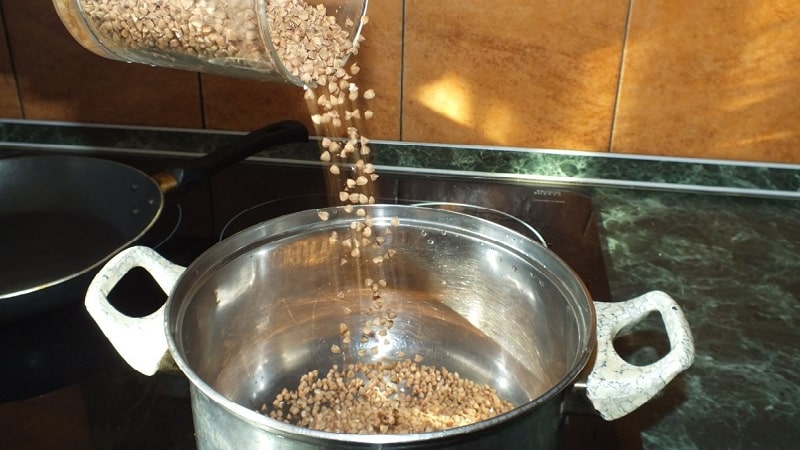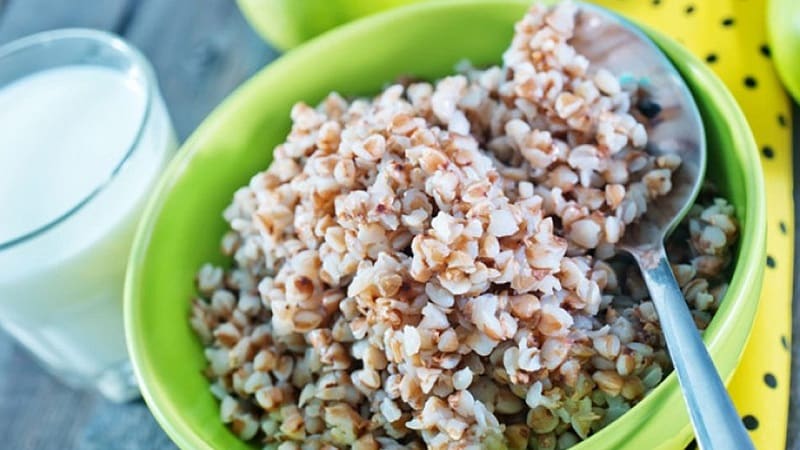How many calories are in buckwheat boiled in water?
Buckwheat is a help for the body in many situations. Low glycemic index, rich mineral composition have a positive effect on health.
The product is nourishing, has a bright taste and aroma, and goes well with vegetables and meat. This cereal is one of the top products for dietary and therapeutic nutrition.
100 or 200 grams of boiled buckwheat - how many calories, which cooking method is preferable - we will answer these and other questions in this article.
How many calories are in buckwheat (50 g, 150 g, 200 g)
Calorie content – the key to normal body weight. Buckwheat porridge is ideal for dietary nutrition. This is a product for those who monitor their weight and health.
It contains:
- complex carbohydrates that are absorbed gradually, so a person does not feel hungry for a long time;
- unsaturated fatty acids;
- potassium, manganese, iron, phosphorus, calcium, magnesium, sulfur, zinc, etc.;
- vitamins of group B, A;
- amino acids;
- mono- and polysaccharides;
- cellulose;
- citric, malic, oxalic, nicotinic – organic acids.
The protein contained in the cereal is similar to meat protein, is easily digestible and is considered one of the main advantages of the product. Wherein buckwheat has a low glycemic index – 49 – and low calorie content.
High protein content (12.6 g per 100 g), micro- and macroelements, fiber makes this product indispensable in dietary and sports nutrition.
The calorie content of buckwheat is influenced by the methods of its preparation and combination with other products.
Boiled in water with and without salt
Buckwheat boiled in water - an inexpensive, satisfying, low-calorie dish. It's easy to prepare.
Buckwheat porridge:
- increases immunity;
- prevents the development of cardiovascular diseases;
- cleanses the intestines and blood vessels;
- increases hemoglobin levels;
- improves brain function;
- lifts the mood;
- lowers cholesterol levels;
- helps build muscle mass;
- improves the quality of hair, skin, nails;
- helps cope with pain and swelling due to arthrosis, arthritis, rheumatism.
Let's determine how many kcal are in 50, 150 and 200 grams of boiled buckwheat with and without salt.
The calorie content of dry cereal is 313 kcal per 100 g of cereal. During the cooking process, the volume increases three times, and the calorie content is 313 kcal per 300 g of porridge.
Respectively:
- 50 g – 52 kcal;
- 150 g – 157 kcal;
- 200 g – 209 kcal.
Before cooking the cereal should be washed thoroughly, pour cold water and put on low heat, closing the lid.
Reference. When cooked, almost all vitamins are destroyed. To avoid this, buckwheat is steamed overnight in a thermos or thick-walled container, wrapped in a towel. For 1 part of cereal take 2 parts of boiling water.
Adding salt to porridge does not affect its calorie content. However, salt retains water in the body. And excess water often adds kilograms.
For quick weight loss, it is better to eat porridge without salt.
Attention! Buckwheat porridge is limited in case of diseases of the pancreas, after abdominal operations.
Buckwheat boiled in water without salt is ideal for mono diets and fasting days. However, you should not replace other products with it. Nutrition should be balanced.
Boiled in water with vegetable oil
Buckwheat porridge with vegetable oil is a higher calorie dish.
Oil is added to porridge during cooking or to the finished product. It can be sunflower, olive or grape seed oil. Vegetable oil added to porridge improves the taste of the dish, acts as a source of omega acids, has a choleretic effect and replenishes the lack of vitamin E.
Calorie content of buckwheat with butter:
- 50 g – 80 kcal;
- 150 g – 240 kcal;
- 200 g – 320 kcal.
Calorie content changes during cooking and depends on the amount of water and oil added. One tablespoon of oil contains 103 kcal. The more water, the lower the calorie content of the final product.
The usual ratio of cereal and water is 1:2.
Conclusion
Buckwheat can replace meat and compensate for the lack of vitamins and microelements. At the same time, the low glycemic index, low calorie content, high content of vitamins and other useful elements make it indispensable for diets, sports, and in the diet of diabetics - since it does not contain gluten. This aromatic dish goes well with vegetables and meat products. Improves the functioning of the entire body, acting comprehensively.
Buckwheat-based diets are easy to implement because they do not make you suffer from hunger. Buckwheat dishes are recommended for children; they contribute to the normal development of a growing organism.


